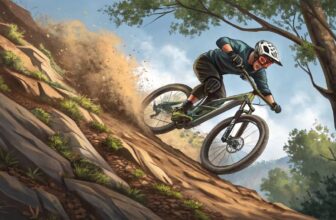Understanding Mountain Bike Gearing
Introduction to Gear Ratios
When it comes to mountain bikes, gearing is the secret sauce that lets riders conquer anything from uphill battles to speedy dashes downhill. It’s a bit like magic but with numbers. If you’re new to the world of pedaling or an old hand at it, grasping gear ratios will make your rides a whole lot smoother.
Basically, this ratio is about how many times your rear wheel spins when you churn the pedals. It’s kind of like trying to balance a seesaw – you need the right setup for the best ride.
Picture this: Your bike’s chainring has 32 teeth while the cassette cog spins with 16. That gives you a 2:1 gear ratio. For every push on the pedal, your wheel goes round twice – great for cruising on the straight and narrow or heading downhill fast. On the flip side, a 1:1 ratio, with equal teeth on the chainring and cog, means easier pedaling, perfect for tackling those nasty hills.
| Chainring Teeth | Cog Teeth | Gear Ratio |
|---|---|---|
| 32 | 16 | 2:1 |
| 32 | 32 | 1:1 |
Importance of Gear Range
Our mountain biking friends know that having the right gear range can make or break your day on the trail. It’s like having a superpower to switch effortlessly between climbing a mountain like a goat and zooming down like a falcon. The gear range, measured in percentages, tells how versatile and flexible your bike’s gear system is.
Bike makers usually spread the word about the range of their gear hubs and boxes. A Rohloff hub with 14 speeds flaunts a hefty 526% range, while the Pinion P1.12 gearbox brags a whopping 600%. But remember, a bigger gear range means you might feel bigger jumps between gears, making smooth shifting a delicate dance.
To work out that range, you can divide the biggest cog by the smallest one. So, a 10-42T cassette has a 420% range, giving Shimano’s 11-46T cassette a run for its money with its 418% range.
| Cassette Size | Gear Range |
|---|---|
| 10-42T | 420% |
| 9-46T | 511% |
| 11-46T | 418% |
Pinning down the right gear range can transform your mountain biking, whether you’re a climber or a speedster. Knowing both gear ratios and range can turbocharge your biking thrill. If you’re keen on more biking tips, take a peek at our guides on mountain bike sizing and mtb trail ratings.
Types of Mountain Bike Drivetrains
Picking the right drivetrain can change your biking game. Two main systems are out there for mountain bikes: 1x and 2x/3x. Each one comes with its own perks and quirks, fitting various riding vibes and trails.
1x Drivetrain System
The 1x (one-by) setup is all the rage with bike folks these days. With just a single chainring in the front, it’s all about keeping things straightforward and cutting down on chain mishaps. Riders who love hitting trails or bombing down enduro courses dig the no-fuss setup.
Key Advantages:
- No Hassle: Fewer parts make it a breeze to handle and keep clean.
- Lighter Feel: Lose the front derailleur and extra chainrings, and you’ve got a bike that’s lighter and zippier.
- Stay on Track: Better chain retention tech means fewer slip-ups over bumpy tracks.
| Component | Description |
|---|---|
| Chainring Count | 1 |
| Common Sizes | 30T, 32T, 34T |
| Cassette Range | 11-50T, 12-51T |
2x & 3x Drivetrain Systems
For those needing more gear choices, 2x and 3x setups offer a buffet of options. They come with either two or three chainrings in the front, plus a multi-speed cassette in the rear for a whole bunch of gear combinations.
2x Drivetrain System
- Adaptability: Having two chainrings gives you gear candy, good for those crazy climbs and speedy stretches.
- Common Specs: Go standard or keep it compact—53/39T, 52/36T, or 50/34T.
3x Drivetrain System
- Gear Galore: Handy for a mix of hardcore climbs and zooming descents.
- More Choices: Loads of gears mean you can always find your sweet spot.
| Component | 2x System | 3x System |
|---|---|---|
| Chainring Count | 2 | 3 |
| Common Sizes | 36T/24T, 38T/28T | 44T/32T/22T |
| Cassette Range | 11-36T, 11-42T | 11-34T, 11-36T |
If the straightforwardness of a 1x system catches your eye, see our 1x mtb conversion guide. For those wanting more gear, our piece on mtb drivetrain compatibility can help you mix and match with ease.
Bottom line, choosing between a 1x system for its low-key vibe or a 2x/3x for its gear buffet depends on where you’re riding and how you roll. Dive into our mountain biking essentials and mtb gear indexing articles for more scoop on making your ride seamless and sweet.
Chainring and Cassette Considerations
Got a mountain bike and want to get the most out of your ride? It’s all in the details of your drivetrain. Let’s chat about those chainring sizes and how you can work out gear ratios. You’ll find the perfect setup for your biking style, guaranteed.
Chainring Sizes and Functions
The chainring—you know, that big spiky wheel by your pedals—decides how well your mountain bike gears up or down, basically defining how much oomph you need to pedal over hills or through tough trails.
- If you’re an uphill warrior: Smaller chainrings are your buddy. They make pedaling uphill feel a tad easier.
- Speed demons, listen up: Bigger chainrings can help you fly on flat or downhill paths by cranking up your speed options.
| Chainring Size | Style Points |
|---|---|
| 28T – 30T | Crushing steep climbs, mastering technical challenges |
| 32T – 34T | All-arounder—perfect for a mix of trails |
| 36T – 38T | When speed and aggression are on the menu |
Your choice doesn’t just stop at size; even the bike’s wheel size counts. If you bump up from a 27.5″ wheel to a beefy 29″, you might need a smaller chainring to keep things feeling familiar.
Calculating Gear Ratios
Want to talk gears? Calculating your bike’s gear ratio is crucial if you want a bike that performs and feels just right. This ratio tells you how the rear wheel responds with each pedal push, which can be game-changing depending on the terrain.
Here’s how you do it: Divide your chainring’s number of teeth by those on the cassette cog. Simple, right? So, for a 32T chainring matched with a 16T cog, your gear ratio stands at 2:1.
And let’s not ignore the gear range—the full stretch between your highest and lowest gear settings. This range is usually a percentage, showing how flexible your drivetrain really is.
| Cassette Size | Gear Range (%) |
|---|---|
| 10-42T | 420% |
| 9-46T | 511% |
| Shimano 11-46T | 418% |
By tweaking these numbers, you can customize your mountain bike’s drivetrain to match your riding mojo. Whether you want a wide range to tackle various terrains effortlessly or a setup honed for specific challenges, understanding gear ratios is your secret weapon.
For more tips on keeping your drivetrain in top shape, check our guide on MTB drivetrain compatibility. Or if you need help picking the right parts, our article on mountain bike maintenance is a click away.
Gearbox Challenges and Advantages
Sure, gearboxes offer some snazzy perks, but they come with their quirks too. Let’s see why some off-roaders weigh in carefully before picking those MTB gear ratios.
Gearbox Limitations
First off, gearboxes on mountain bikes are nifty—but not without some hiccups, as pointed out by Bike Radar.
- Weight: They’re on the chunky side, heavier than the old-school derailleur setups, and that can slow down your groove.
- Drag: This fancy gadget’s insides create more friction, which means you gotta pedal harder to keep your pace up.
- Custom Frames: These little beasts need special frames to fit in, so not every bike frame makes the cut.
- Shifting Limitations: The switch-up might be a bit sluggish, especially if you’re pushing hard on the trails.
In short, these quirks make them a rare—and sometimes avoided—choice among mountain bikers.
| Bump in the Road | What’s the Deal? |
|---|---|
| Weight | More heft compared to derailleur setups |
| Drag | Adds friction, reducing pedaling ease |
| Custom Frames | Needs a special frame to mount |
| Shifting Limits | Not the smoothest when under load |
Gearbox Benefits
But don’t count gearboxes out just yet; they’ve got some tricks up their sleeves that keep them in the game, according to Bike Radar.
- Durability: These babies are cocooned away from the dirt, dust, and slush, making ‘em tough cookies and long-lasting.
- Suspension Performance: With weight snugly central, your ride gets some extra oomph in handling and steadiness over rough and tumble terrains.
- Low Maintenance: Tucked-in gears mean fewer touch-ups—less mess, less fuss.
- Consistent Shifting: Internal shifts aren’t bothered by muck, keeping the ride smooth and steady come rain or shine.
| Perk | What You Get |
|---|---|
| Durability | Safe from the messy outdoors |
| Suspension Performance | Better grip and control |
| Low Maintenance | Fewer repairs, more time to ride |
| Consistent Shifting | Dependable gear every single trip |
If you’re toying with the idea of upgrading, think about weighing these mountain bike maintenance needs against the bling they bring. Gearboxes may lure in the pros going for toughness and smooth rides, but the heaviness and fitting qualms keep them from winning the popularity contest in the cycling world.
Craving more tips on jazzing up your ride? Dive into our guides on mtb suspension setup or wise up on mtb drivetrain compatibility.
Practical Gear Selection Tips
Choosing the right gears for your mountain bike is like finding that sweet spot in a playlist—the one where your legs feel just right, and the path ahead is pure joy. Your own fitness, how you like to pedal, and where you’re riding all play a part in picking those perfect gears.
Choosing Optimal Gear Ratios
When you’re gearing up, think of it like Goldilocks looking for what’s “just right”—not too easy, not too hard, but just right for your strength and the trail. Some key things to keep in mind include:
- Fitness Level: If you’re puffing after a single flight of stairs, you might want to stick to easier gears. But if you’ve got thighs of steel, higher gears could be your jam.
- Preferred Cadence: Most folks find that pedaling between 70-90 revolutions a minute feels right, kind of like your favorite beat.
- Steepness of Trail: On those mountain climbs that make you question life’s choices, you’ll want easier gears to keep from burning out. But on flat or downhill runs, harder gears help you fly.
These days, a no-nonsense 1x drivetrain is in vogue for good reason—it keeps things simple without skimping on options. That 32-tooth chainring? Well, it’s the MVP for keeping everything running smoothly on most full-suspension bikes.
| Chainring Size (Teeth) | Ideal Terrain | Comments |
|---|---|---|
| 28-30 | Steep, tricky climbs | Keeps your legs spinning when the going gets tough |
| 32-34 | General trails | A good all-rounder for whatever the trail throws at you |
| 36-38 | Flat or rolling hills | Lets you cruise on mellow terrain with ease |
Adjustments for Terrain Features
Understanding what’s ahead can make a world of difference when gearing up. Here’s how you can tweak your bike to better tackle different terrains:
- Climbs: When you’re crawling up a hill, switch to a smaller chainring and a big cog in the back. Easier is better than straining and potentially walking!
- Descents: Going down? Crank up to a bigger chainring with a small cog in the back for some speed thrills.
- Technical Sections: For those gnarly, rooty paths, keep it middle-of-the-road with your gear choices, so you’re ready for whatever jumps out at you.
Getting the right gears isn’t just about smooth rides; it’s about keeping your gear happy too. Regular TLC—tender loving care—keeps your bike in tip-top shape. If you want to know more about looking after your bike, check out our guide on mtb drivetrain compatibility.
| Terrain Type | Recommended Adjustments |
|---|---|
| Steep Climbs | Go small upfront and big at the back |
| Technical Sections | Stick with middle gears for quick responses |
| Descents | Bigger upfront, smaller at the back to go faster |
Finding the perfect gear combo is a bit of a dance—it takes some trial and error on your favorite trails. For more tips on stepping up your riding game, browse through our articles on mountain biking basics and MTB trail ratings.
Maintenance and Performance Tips
Proper maintenance and making sure your mountain bike’s gearing system is running smoothly are key to a fun and trouble-free ride. Here we’ll dive into the basics of maintaining your gear system and weigh the pros and cons of electronic vs. old-school mechanical gears.
Drivetrain Maintenance Basics
Getting in the habit of maintaining your bike’s drivetrain is essential, especially if you’re tearing up trails on the regular. Give your bike a little TLC after each ride by cleaning and lubing up the drivetrain. This keeps the grime at bay, so your gears don’t end up grinding to a halt.
Here’s the lowdown on keeping your drivetrain happy:
- Chain cleaning: Use some degreaser to bust that gunk off and strip away any old lube.
- Chain lubing: Get your hands on a good, bike-specific lube and slick it on.
- Cassette and chainring check: Keep an eye out for signs of wear and replace them before they go kaput.
A little pampering goes a long way, ensuring a longevity boost and gears that work like a charm. Need more detailed instructions? We’ve got plenty of tips on mountain bike maintenance and how to clean mountain bikes.
Benefits of Electronic vs. Mechanical Gears
Deciding between electronic and mechanical gears for your mountain bike? Each has its own set of perks and quirks.
Electronic Gears
Going the electronic route? Here’s the scoop: they’re all about precision, speed, and smart shifts.
- Nifty Shifts: They do the gear-changing dance in a snap.
- Steady Performance: They handle cable tweaks like a pro, so your ride stays smooth.
- Make it Your Own: Tweak it to fit how you like to ride.
But it’s not all rainbows:
- Pricey: Be ready to shell out more upfront.
- Juiced Up: Regular battery check-ups and charges keep them in action.
Mechanical Gears
If you prefer the tried-and-true mechanical gears, you’re in good company. Here’s why they’re a hit:
- Wallet Friendly: Easy on the budget compared to their electronic cousins.
- User-Friendly Maintenance: Easier to fiddle with, no electronics required.
Just keep these in mind:
- Cable Stretch: Watch for stretch and give ‘em a tweak now and then.
- Less Precision: The shifts might get a bit wobbly, especially after a workout session.
| Feature | Electronic Gears | Mechanical Gears |
|---|---|---|
| Cost | High | Moderate |
| Maintenance | Moderate (battery care) | Low (simple adjustments) |
| Shift Precision | High | Moderate |
| Customization | High | Low |
| Weight | Slightly Higher | Lower |
Knowing the strengths and hiccups of each can help you pedal off with the right setup. Fancy some more guidance? Check out mtb drivetrain compatibility and diy mountain bike repairs.
In the end, the choice boils down to what matters most to you: tweaking precision, saving cash, or keeping things simple maintenance-wise.
Gear Systems Across Bike Types
Taking a close peek at gear systems across various bikes shows how mountain bike (MTB) gears fit into different riding styles and terrain. Here, we check out the twists and turns of gearing in gravel and cyclocross bikes, mixing it up with road and mountain bike gears.
Gravel and Cyclocross Gearing
Gravel and cyclocross bikes are like the cool kids on the block – they mix road and mountain bike traits. They usually sport smaller double chainring setups compared to road bikes. A typical combo in cyclocross is 46/36 and for gravel, you might see 48/31, ready to handle a mix of terrains.
These bikes also keep it simple with single ring setups, usually around 40 or 42 teeth. Cyclists pick sizes based on what they’re planning to ride. For example:
| Bike Type | Typical Chainring Sizes |
|---|---|
| Cyclocross | 46/36, 40 (1x) |
| Gravel | 48/31, 42 (1x) |
Your chainring size can affect how you handle the climb versus the speedy parts. Smaller rings make uphill battles easier, while bigger ones let you zip along flat stretches. For tips on keeping your gear in top shape, check out our guide on mtb chain maintenance.
Blending Road and Mountain Gearing
MTBs often run on a 1x drivetrain, giving a wide spread of gear ratios perfect for going off-road. Picking the right chainring matters; smaller rings (like 28t or 30t) make hills easier, while larger ones (like 34t or 36t) help speed along the flats and downhills.
| Chainring Size | Type | Purpose |
|---|---|---|
| 28t – 30t | Small Chainring | Easier climbing |
| 34t – 36t | Larger Chainring | Faster speeds |
When mixing in road bike elements, keeping a straight chain line is key for smooth riding and reduced wear. Avoid extreme chain angles to keep everything running neatly and minimize wear. For more about adapting drivetrains, check our piece on mtb drivetrain compatibility.
Also, swapping wheels or rear chainrings changes gear ratios a lot. Shifting a rear wheel from 28″ to 26″ with the same chainring bumps the gear to 93 gear inches, showing how big a role wheel size plays.
By getting a handle on gear systems across bike types, riders can tweak their rides for all kinds of paths, making for a better biking adventure. Whether mixing road and mountain gear or setting up for gravel and cyclocross, picking the right gear ratio keeps your ride smooth.
For newcomers or those seeking an upgrade, check out our articles on mtb bottom bracket types, mtb gear indexing, and 27.5 vs 29er mtb to get the most out of mountain biking.




